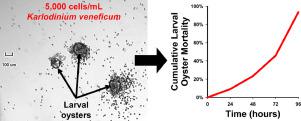Harmful Algae ( IF 6.6 ) Pub Date : 2020-12-26 , DOI: 10.1016/j.hal.2020.101965 Sarah K.D. Pease , Kimberly S. Reece , Jeffrey O'Brien , Patrice L.M. Hobbs , Juliette L. Smith

|
Harmful algal bloom (HAB) dinoflagellate species Karlodinium veneficum and Prorocentrum cordatum (prev. P. minimum) are commonly found in Chesapeake Bay during the late spring and early summer months, coinciding with the spawning season of the eastern oyster (Crassostrea virginica). Unexplained larval oyster mortalities at regional commercial hatcheries prompted screening of oyster hatchery water samples for these HAB species. Both HAB species were found in treated hatchery water during the oyster spawning season, sometimes exceeding bloom cell concentrations (≥ 1,000 cells/mL). To investigate the potential for these HAB species, independently or in co-exposure, to affect larval oyster mortality and activity, 96-h laboratory single and dual HAB bioassays with seven-day-old oyster larvae were performed. Treatments for the single HAB bioassay included fed and unfed controls, K. veneficum at 1,000; 5,000; 10,000; and 50,000 cells/mL, P. cordatum at 100; 5,000; 10,000; and 50,000 cells/mL. Subsequently, the 1,000 cells/mL K. veneficum and 50,000 cells/mL P. cordatum treatments were combined in a co-exposure treatment for the dual HAB bioassay. At all cell concentrations tested, K. veneficum swarmed oyster larvae and caused significant larval oyster mortality by 96 h (Karlo1,000: 21 ± 5%; Karlo5,000: 93 ± 2%; Karlo10,000: 85 ± 3%; Karlo50,000: 83 ± 5%, SE). In contrast, there was no significant difference in larval oyster mortality between the control treatments and any of the P. cordatum treatments by 96 h. By 24 h, larval oysters were significantly less active (immotile) in the presence of either HAB species as compared to control treatments (e.g., Karlo1,000: 37.8 ± 4.1%; Proro100: 47.3 ± 7.4%; Fed: 10.8 ± 3.2%; Unfed: 10.1 ± 4.9%, SE). In the dual HAB bioassay, larval oyster mortality associated with 1,000 cells/mL K. veneficum (44 ± 9%, SE) was not changed by the addition of 50,000 cells/mL P. cordatum (55 ± 7%, SE), demonstrating that K. veneficum was primarily responsible for the observed mortality. This study demonstrated that even low cell concentrations of K. veneficum and P. cordatum are harmful to larval oysters, and could contribute to reductions in oyster hatchery production through impacts on this critical life stage.
中文翻译:

两个HAB的牡蛎孵化场的突破及其对东部幼体牡蛎(Crassostrea virginica)的潜在影响。
有害藻华(HAB)藻种Karlodinium veneficum和原甲藻cordatum(前P.最小)是在春末和夏初个月,切萨皮克湾中常见的,与东部牡蛎的产卵季节(重合牡蛎弗吉尼亚)。区域性商业孵化场的原因不明的幼体牡蛎死亡率促使针对这些HAB物种筛选牡蛎孵化场水样。在牡蛎产卵季节,在经过处理的孵化场水中发现了两种HAB物种,有时超过了开花细胞浓度(≥1,000细胞/ mL)。为了研究这些HAB物种独立或共同暴露对幼虫牡蛎死亡率和活性的潜在影响,我们对7天大的牡蛎幼虫进行了96小时的实验室单和双HAB生物测定。单一HAB生物测定的处理方法包括进食和未进食的对照,K。veneficum,1,000;5,000; 10,000; 和50,000细胞/ mL,P. cordatum为100; 5,000; 10,000; 和50,000细胞/ mL。随后,以1,000个细胞/ mL的K. veneficum将50,000个细胞/ mL脐带假单胞菌处理组合在一起进行共同暴露处理,以进行双重HAB生物测定。在所有测试的细胞浓度下,K。veneficum聚集牡蛎幼虫并在96 h内引起明显的幼虫牡蛎死亡率(Karlo 1,000:21±5%; Karlo 5,000:93±2%; Karlo 10,000:85±3%; Karlo 50,000:83 ±5%,SE)。相比之下,在96 h之前,对照处理与任何脐橙假单胞菌处理之间的幼虫牡蛎死亡率没有显着差异。到24小时时,与对照处理相比,在任何一种HAB物种存在下,幼虫牡蛎的活动(不活动)明显降低(例如,Karlo 1,000:37.8±4.1%;Proro 100:47.3±7.4%;美联储:10.8±3.2%; 未进纸:10.1±4.9%,SE)。在双重HAB生物测定中,添加50,000个细胞/ mL脐带假单胞菌(55±7%,SE)不会改变与1,000细胞/ mL veneficum(44±9%,SE)相关的幼体牡蛎死亡率,这表明该K. veneficum是所观察到的死亡率的主要原因。这项研究表明,即使低浓度的K. veneficum和P. cordatum细胞也对幼体牡蛎有害,并可能通过影响这一关键生命阶段而导致牡蛎孵化场生产的减少。



























 京公网安备 11010802027423号
京公网安备 11010802027423号